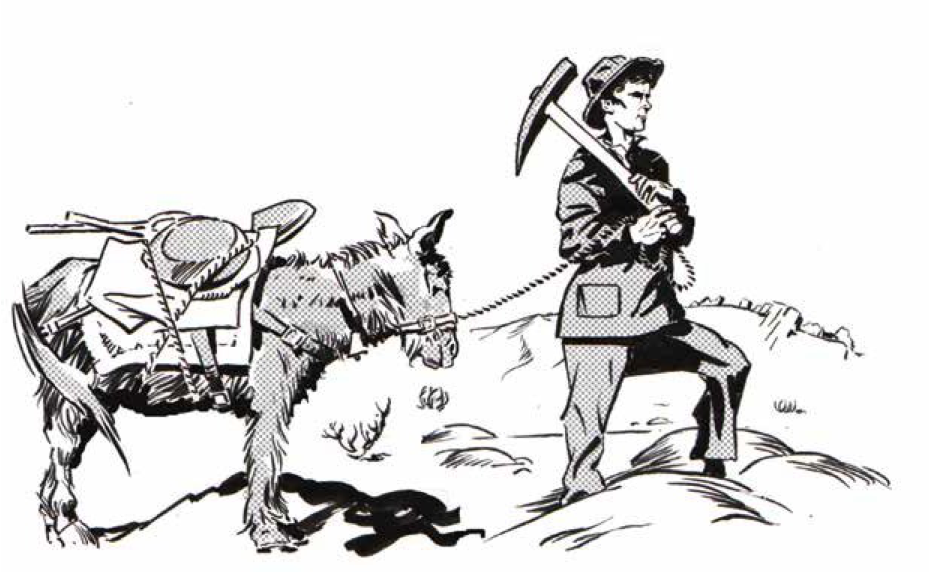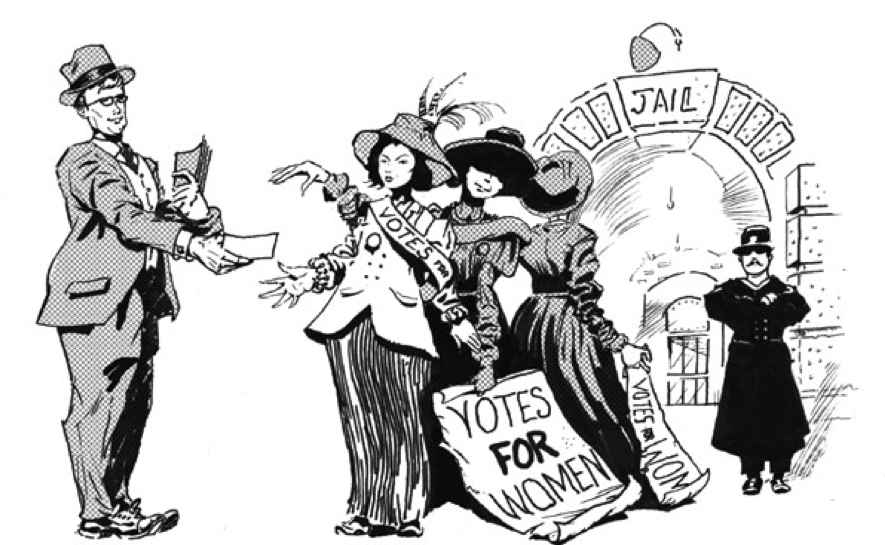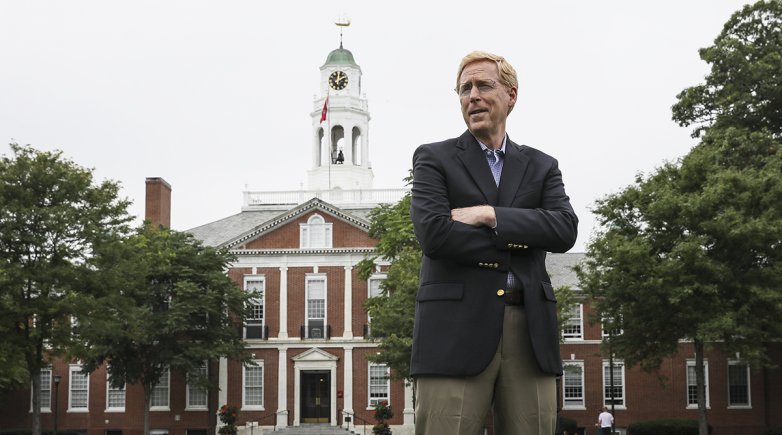The boy from Montana
William Boyce Thompson’s time at Exeter was brief, but his legacy is everlasting.
On Friday, May 14, 1926, The Wall Street Journal, a newspaper accustomed to providing its readership with breaking news of the world’s financial markets, ran an article that instead simply reported a birthday. Beyond mention of the individual’s “sojourning at the Ritz Hotel, Madrid, Spain” the article imparted no news of note. Clearly however, whenever this person’s birthday rolled around, the Journal thought it newsworthy enough to alert its readers. The article began, “Colonel William Boyce Thompson celebrated his fifty-seventh birthday Thursday.”
By 1926, such personal information about Thompson had become commonplace in the press. The Boston Daily Globe once reassured the public, in reporting on a recent illness, that Thompson’s “physicians say he is in no immediate danger.” Such a positive report, other papers noted, produced a rally in the financial markets. On a more cheerful note, The New York Times reported that the colonel had entertained “at tea on board his yacht, Savargra, [sic] the Duke and Duchess of Aosta.”
This rise to such public notoriety belies a rough-and-tumble beginning on the frontiers of the American West.

Thompson spent his youth amid the thousands for whom fortune, much more than fame, had drawn to the Montana Gold Rush sites in Alder Gulch during the 1860s. This was a land that had only recently surrendered its version of vigilante justice to more decorous methods, but not before Thompson’s father had helped dispatch five desperadoes simultaneously on a scaffold that he had constructed himself. By his teenage years — when the family had moved to Butte, where copper had produced another stampede of fortune-hunters — Thompson admitted to having little interest in serious matters. At 15 he was a formidable poker player in the local saloons, which populated every street corner. This pastime replaced earlier ventures designed to enlarge his fortune — a vegetable stand one summer, prospecting the next, an opera house candy concession another. Early on, Thompson recognized what would increase the world’s bounty, and his own — what came from the soil.
Early on, he evinced his intention to take his share. Though school seemed to him eminently impractical, Thompson did attract the attention of the man whose advice would change his life. Arthur Cotton Newell of Balliol College, Oxford, a classics scholar hired to instruct the children of a British engineer relocated to Butte, had found himself unemployed when his benefactor lost his fortune, and he willingly took the position of local schoolmaster. Recognizing Thompson as a talented student in mathematics with a restless and imaginative mind, Newell plied him with serious books that revealed a world of much greater possibility than what awaited him in Butte. Newell’s suggestion of an eastern boarding school promised an adventure worth considering, made possible by his father’s recent financial success. Knowing that a hero of his, Daniel Webster, had attended such a school, Thompson looked to Phillips Exeter.
Arriving at the Academy in January 1887, Thompson entered a school in transition and seemingly moving in the wrong direction. Though growing in enrollment — up to 320 students when Thompson arrived, an increase of 50 percent in just 10 years — students distinguished themselves as much by their rowdy behavior as by their scholarship. Principal Walter Quincy Scott, who had served in the Civil War under General Sherman, called for police protection to control student riots and rode his large white horse around campus to intimidate malcontents, thus obviating the need for the brass knuckles worn by his successor.
Young William made his own contributions to this mayhem, participating with relish in illicit poker games, where now his victims included not only fellow students but Boston card sharks. Other objects of his mischief included the fence at the Robinson Female Seminary, which he helped set afire, and Professor Tufts’ cow, which in darkness he and others led onto the chapel rostrum. More important to his future, Thompson finally began to take academics seriously and to choose courses that served his growing interest in the world of commerce and his understanding of mining’s potential in America. A vacation visit to New York, where he witnessed brokers dealing mining shares on the stock exchange, prompted him to think ahead to a future where the classics were surely less important than the sciences. Therefore, out with Latin and Greek and in with chemistry and physics.
Outside class he contributed to The Exonian and the Exeter Literary Monthly, for which he wrote articles describing his firsthand knowledge of the wonders of the West. His Exeter course selections, his extracurricular choices and even his rule-breaking foreshadowed what would consume so much of his adult life — taking risks and using science to explore the riches that lay in the earth, particularly in the mountains of Montana.
Moreover, the friends he made at Exeter would remain close to him for the rest of his life. The importance of all this to Thompson was expressed much later by his widow, Gertrude, in a letter to Lewis Perry, who would as principal become the steward of the many gifts that Thompson would bestow on the Academy. She wrote, shortly after Thompson’s death: Dear Dr. Perry, I am sure you have always known [my husband’s] deep friendship and affectionate regard for you and the happiness it gave him to know that you had in charge his beloved Exeter. Exeter, of course, filled a very large part of his heart, and I think one of the greatest joys of his life was to assure the expansion and endurance of his real alma mater. All of his ideas — patriotic, scientific and construction — seemed to have melded themselves into his love for Exeter.
Enjoyable as Exeter had been, Thompson was a young man in a hurry … and practical, which explains his leaving the Academy as soon as he had acquired sufficient credits to further his education, not at the liberal arts colleges favored by Exeter graduates, but rather at the Columbia School of Mines in New York. But more than a student he was a gambler, and after only one year he abandoned the classroom to pursue the dream of silver riches in an abandoned mineshaft discovered during the summer back home in Butte. Alas, in what was to be the first of many failed ventures, this gamble failed to pay off. Over the next 10 years, Thompson’s efforts to turn silver, lumber and coal to profitability produced little, enough to sustain his new wife and child perhaps, but nothing to match his ambitions. Then came the Shannon mine, the beginning of a string of successes that would make him an internationally known mining entrepreneur and a giant of Wall Street.
By 1899, when Thompson first heard of Shannon, demand for copper had never been higher — it was needed for the wires to transmit telephone and telegraph messages, for the electricity to move streetcars, and for the lights to illuminate the nation’s offices and homes. Copper would enable Americans to enjoy all that, if someone could find enough of it. Thompson intended to do just that. Meeting personally with the Shannon owners, who were looking to sell their property for $250,000, Thompson managed to secure ownership for $500 down with the promise to provide another $100,000 within a year. Now all he had to do was to find investors. Using all his contacts and friendships, including his Exeter friends, Thompson paid for the property, made improvements and waited for the mine to produce.
It did, abundantly. Investors recouped windfall profits and news quickly spread, bringing admirers willing to financially support more Thompson projects, which came fast. Hiring private railroad cars to transport interested partners to investment sites, Thompson had little trouble finding the capital to expand his properties. Over the next 20 years would come more copper mines, as well as zinc mines in Missouri and Oklahoma, the world’s largest sulfur mine in Texas, tungsten properties in Peru, an iron mine in Brazil, diamonds in South Africa and silver in China. Companies of all sorts — dealing in tobacco, airplanes, life insurance, and oil — offered Thompson directorships, as did the Federal Reserve Bank in New York. Politics increasingly occupied his attention, particularly the prospects of Theodore Roosevelt and the Republican Party, and Thompson became a presidential elector and champion of Roosevelt. By 1920, Thompson had become wealthy and famous, the kind of person, say, whose birthday was significant enough news for The Wall Street Journal to report to its readers.
As with any rich man, many individuals and institutions approached Thompson with ways to relieve him of the burdens of all that wealth. National and world events commanded his attention, and the causes to which he contributed reveal much about his values.

In 1917, when 100 women picketing the White House in support of women’s suffrage were manhandled by the police and tossed in jail, Thompson gave each of them $100, the equivalent of $2,000 today, and contributed nearly $200,000, in today’s dollars to their cause.
When Herbert Hoover, as head of Belgian relief, sought funds in 1917 to relieve the suffering of that war-ravaged country, Thompson first donated the equivalent of $2 million and then helped Hoover raise an additional $100 million, just from his close friends.
At the outset of America’s own participation in World War I, Thompson’s gifts to war bond drives and the Red Cross totaled more than $5 million.
Later in the war, Thompson became a prominent player in international politics. Appointed head of the Red Cross Mission to Russia in the spring of 1917, which carried with it the rank of colonel, Thompson traveled to Russia and spoke often with Alexander Kerensky, head of the Provisional Government, which had replaced the Czar. In response to Kerensky’s stated need for funds to solidify his government’s standing, Thompson wrote a check for $20 million in today’s dollars.
Having seen in Russia the political danger of wide-spread famine, Thompson committed himself to feeding the world’s population, a challenge he feared would face all nations. To meet that challenge, he established the Boyce Thompson Institute for Plant Research, a large laboratory of scientists devoted to the research necessary to ensure the world’s food supply. That it remains an important research facility today, now on the campus of Cornell University, is no doubt due at least in part to the endowment Thompson established with a gift of $10 million, or $150 million in today’s dollars.
When Thompson built a large house in Arizona, he also built nearby the Thompson Arboretum, to collect and study varieties of desert plants, which today exists as the largest state park in Arizona.
Clearly, Thompson recognized a responsibility to support causes that would benefit citizens of the United States and of the world. The extent of his impact, however, remains somewhat a mystery, as at the time of his death his obituary in The New York Times stated, “Many of his large philanthropies will probably never be known, as he was always averse to having his name appear in connection with his gifts.”
In the last decade of his life, the largesse bestowed on one beneficiary indicates the hold it had on his affections. His Exeter friend Thomas Lamont ’88, head of JP Morgan, asked Thompson — after he had become a man of great fortune and celebrity — what he wanted in life. Thompson’s response: “to be a trustee of Exeter.” Thompson became a trustee in 1920 and would remain so until his death in 1930. In 1916, he had given the Academy a new gymnasium, along with a swimming pool and tennis courts. Then, in 1927, Principal Lewis Perry wrote Thompson, saying that he had “made a list of what seemed to be the greatest needs of the school.” The list of six items included a science laboratory, a covered cage and a new administration building. Two weeks later, Perry received a response: How much for items 2 through 6, asked Thompson, and when each was itemized, Thompson proceeded to fund a new science building, the Cage and Jeremiah Smith Hall, at a cost of $8 million in today’s dollars.
The first item on the list had been money for an endowment, which Perry had attempted to grow with little success. On Jan. 28, 1930, Perry received the following telegram:
To Lewis Perry: Yesterday Colonel Thompson gave Exeter one million dollars cash [$15 million in today’s dollars] following idea he long had in mind gift to be used as trustees judge best but Thompson thinks more attention could be given educating boys in a scientific way and possibly some could be applied in that direction STOP he also feels good deal of care should be used in handling seemingly backward boys who might thereby get through successfully …

Beyond these gifts, Thompson also donated money to help build three dormitories, for scholarship funds, and for teaching funds. In all, Thompson’s gifts to Exeter totaled approximately $30 million in today’s dollars. Principal Perry was not indulging in hyperbole when he said, acknowledging all these gifts, that in a very real sense Thompson could be considered the second founder of the Academy.
Sadly, Thompson did not live to see what his generosity made possible, succumbing to pneumonia in 1930. He had not been kind to his health; his prodigious appetites for work, food and cigars — as many as 40 a day — took a toll over time. These qualities one might expect in the life of a Wall Street tycoon in the early 20th century. Yet they obscure other qualities that one might applaud. Not long after his death, Lamont said of him, “W.B … he was called W.B. from schoolboy days … always struck me as the complete philosopher. He was amused and serene …” One doesn’t normally think of philosophy when considering the lives of those called, alternatively, “captains of industry” or “robber barons.” Nor does one normally use the term idealist when explaining how Wall Street millionaires made their fortunes. But consider these words of W.B., spoken at an Exeter alumni reception in New York over which he presided as its president.
“… youth is a period of life when we walk on the summits, and it is a period with which we break contact at our peril. It is a period of magnificent dreams, of gay courage, of a readiness to serve, and a willingness to sacrifice that knows no withholding. The world of action and competition is not particularly gentle; it is not particularly tender with youthful aspirations. It breaks them, if it can; and if it cannot, it clouds the fine glamour of them with the smoke of conflict. The best of dreams have a way of going glimmering. We smile in our maturity at what we call our ‘boyish illusions’; but if we do that, we do wrong. The judgment of youth on essential things has a way of being clearer and surer than the judgment of maturity. It is only in the worldly inessentials that 50 has the advantage of seventeen.”
Thompson had thrived in that world of action and competition, achieving success and fortune far greater than most, yet here he is celebrating his 17-year-old world, which for him was the world of Exeter. One can imagine that those many gifts he left behind for Exeter, for his country and for humanity were intended to fulfill the dreams, the ideals, those boyish illusions he had back then.
Editor's note: This article first appeared in the fall 2018 issue of The Exeter Bulletin.




